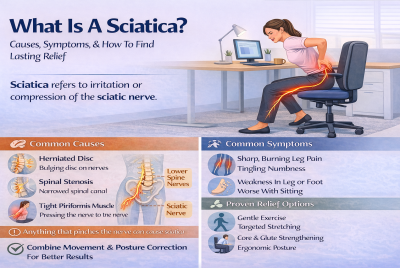Heat Or Ice For Sciatica
Discover when to use heat or ice for sciatica relief. Dive into expert advice to ease pain and get back to life. Find out which works best! Should I use heat or ice for sciatica? Depending on the situation, heat and ice can be effective for sciatica, but first and foremost, let’s talk about sciatica. What is it? It’s a pain, literally and figuratively, that radiates along the path of the sciatic nerve, which branches from your lower back through your hips and buttocks and down each leg. Typically, sciatica affects only one side of your body.
Common Causes Of Sciatica
An underlying condition, such as a herniated disk, spinal stenosis, or a pinched nerve, usually causes sciatica. Have you ever had a pebble in your shoe? That’s kind of what these conditions feel like to your sciatic nerve, only much worse.
Treatment Options For Sciatica
Conventional Treatments
Many treatments are available for sciatica, ranging from medication to physical therapy and, in extreme cases, surgery. Conventional treatment options for sciatica include:
- Physicians prescribe pain relievers to reduce inflammation and pain.
- Physical therapists design targeted exercises to strengthen back muscles and improve posture.
- Chiropractors adjust the spine to relieve nerve pressure.
- Acupuncturists insert needles at specific points to alleviate pain.
- Massage therapists use techniques to relax tense muscles and improve blood flow.
- Some doctors recommend epidural steroid injections to reduce inflammation around the nerve.
- If conservative treatments fail, surgeons might perform procedures to relieve nerve compression.
Patients should consult their healthcare providers to determine the best treatment approach for their specific situation.
The Role Of Heat And Ice
The Case For Heat Therapy
How Heat Therapy Works
Heat therapy works by increasing blood flow and relaxing your muscles. It’s like giving your sciatic nerve a warm, comforting hug.
Pros Of Heat Therapy
Heat can be quite beneficial, as it aids in relaxation and provides immediate comfort. It’s like a bowl of warm soup on a cold day – comforting, right?
Pros of heat therapy for sciatica include:
- Heat relaxes tense muscles surrounding the sciatic nerve.
- It promotes blood circulation, aiding in nutrient and oxygen delivery to the affected area.
- Heat therapy can provide immediate pain relief.
- It increases flexibility, reducing the risk of further muscle strains.
- The treatment is easily accessible; patients can use heating pads, warm towels, or hot packs at home.
- It’s a non-invasive treatment option.
- Heat therapy complements other treatments like physical therapy and medication.
- It’s cost-effective and doesn’t require a prescription.
Always consult with a healthcare provider before starting any treatment.
Cons Of Heat Therapy
But it’s not without its drawbacks. Prolonged heat application can cause burns and heat discomfort.
Cons of heat therapy for sciatica include:
- Heat can aggravate inflammation if used immediately after an injury.
- Prolonged use can cause burns or skin irritation.
- It might not address the root cause of sciatica, offering only temporary relief.
- Over-relying on heat may delay seeking more comprehensive treatments.
- Some people may find the sensation uncomfortable or too intense.
- It’s not always suitable for individuals with certain medical conditions or skin sensitivities.
- Heat therapy might only be effective for some.
- Using high temperatures can increase swelling in the affected area.
Always consult with a healthcare provider before starting any treatment.
So Can Heat Help Sciatica Pain?
Yes, Heat can be beneficial in managing sciatica pain. Heat therapy works by increasing blood flow and relaxing muscles, which can help reduce spasms and discomfort associated with sciatica. It’s especially effective for chronic sciatica pain, where the nerve irritation is persistent, and the muscles may be tense or spasming.
Heat therapy can come in various forms, such as a warm bath, a hot pack, or a heating pad. It’s essential to remember to never apply heat directly to the skin and to limit each session to 15-20 minutes at a time to avoid burns.
However, it’s important to note that everyone is different, and what works for one person might not work for another. Some people find more relief with cold therapy rather than heat, or a combination of both. As always, it’s crucial to consult with a healthcare professional to discuss the most appropriate treatment strategy for your specific situation.
The Case For Ice Therapy
How Ice Therapy Works
On the flip side, ice therapy works by reducing inflammation and numbing the painful area. Think of it as a ‘chill pill’ for your nerve.
Pros Of Ice Therapy
Ice can help reduce swelling and numb the pain, much like how a cold pack soothes a bump on your head. Pros of ice therapy for sciatica include:
- Ice reduces inflammation around the sciatic nerve.
- It provides immediate numbing, alleviating pain.
- Ice therapy can limit swelling after an injury.
- It’s a non-invasive and drug-free option for pain relief.
- Patients can easily apply ice packs or cold compresses at home.
- It’s a cost-effective treatment.
- Ice therapy complements other treatments like medication or physical therapy.
- Regular application can provide consistent relief for acute flare-ups.
Always consult with a healthcare provider before starting any treatment.
Cons Of Ice Therapy
However, like heat, it can cause discomfort with prolonged use, such as skin irritation and frostbite in extreme cases. Cons of ice therapy for sciatica include:
- Ice can stiffen muscles, reducing flexibility temporarily.
- Prolonged use can cause frostbite or skin irritation.
- It might provide only temporary pain relief without addressing the root cause.
- Overusing ice can reduce blood flow excessively, slowing healing.
- Some people find the cold sensation uncomfortable.
- It’s not suitable for individuals with certain medical conditions or skin sensitivities.
- Using ice immediately before activities can decrease muscle performance.
- Ice therapy might only be effective for some, as pain responses vary.
Always consult with a healthcare provider before starting any treatment.
So Can Ice Help Sciatica Pain?
Yes, ice can indeed help with sciatica pain. Ice therapy, or cryotherapy, reduces inflammation and numbs the painful area. This is especially beneficial when the sciatica pain is acute, caused by a recent flare-up or injury, and there’s significant inflammation present.
An ice pack can help reduce the swelling that might be compressing the sciatic nerve and alleviate the pain. It’s like using a cold pack on a sprained ankle or a bumped head.
Like heat therapy, it’s important to use ice safely. Never apply it directly to the skin – always wrap it in a towel or use a commercially available cold pack. And limit your sessions to 15-20 minutes at a time to prevent skin damage.
Again, different people respond differently to treatments, so while some may find more relief with ice, others might find heat more beneficial or a combination of both. Always consult with a healthcare professional for personalized advice.
Heat Versus Ice: Making The Choice
When To Use Heat
Now, the question arises, when should you use heat? Heat is best for chronic conditions to relax, loosen tissues, and stimulate blood flow to the area. Use heat for stiffness, chronic pain, or stress that results in spasms. It’s like an internal massage, gently easing those knotted muscles.
When To Use Ice
As for ice, it’s better for acute injuries to help minimize the swelling, much like applying an ice pack to a sprained ankle. Ice is your best bet if the pain is recent and inflammation is high, much like a cool drink on a hot day.
Is Heat Or Ice Better For Sciatica?
Deciding between heat or ice for sciatica depends on the individual’s symptoms and duration. Ice effectively reduces inflammation and provides immediate numbness to the affected area. It’s beneficial during the initial 48 hours after the onset of pain. Heat, on the other hand, relaxes and loosens tissues. It stimulates blood flow to the region, which can help relieve muscle tightness and chronic discomfort. Some people benefit from alternating between heat and ice, experiencing comprehensive relief. Personal preferences play a role; some may favor the soothing nature of heat, while others prefer the numbing effect of ice. Always use a barrier, like a cloth, to protect the skin from direct contact. For the best-personalized advice, consult a healthcare provider.
Ice Or Heat For Lower Back Pain Sciatica
For lower back pain due to sciatica: Ice reduces inflammation and numbs the area, offering relief and best used within the first 48 hours of pain onset. Heat relaxes muscles and promotes blood flow, easing chronic discomfort and muscle tightness. Some find alternating between ice and heat effective. Individual preferences matter; some prefer ice’s numbing, others the warmth of heat. Always use a barrier, like a cloth, to shield the skin from direct contact. Neither approach addresses the underlying cause, so they’re often part of a broader treatment plan. Consult a healthcare provider for personalized recommendations.
Is Heat Or Ice Better For Nerve Pain?
Deciding between heat or ice for nerve pain depends on the nature and duration of the symptoms. Ice helps numb the affected area, reducing immediate pain and inflammation. It’s often recommended shortly after injury or pain onset. Heat can relax surrounding tissues, promote blood flow, and alleviate muscle spasms often associated with nerve pain. Some people benefit from alternating between the two, using heat for relaxation and ice for numbing. Individual preferences play a significant role; while some appreciate the warmth, others prefer the numbing effect of cold. Always use protection, such as a cloth, to prevent skin damage. Consulting a healthcare provider will guide the most effective treatment strategy.
How Do I Get My Sciatic Nerve To Stop Hurting?
To alleviate sciatic nerve pain:
- Rest briefly, but avoid prolonged inactivity as it can worsen symptoms.
- Apply ice or heat to the affected area. Ice reduces inflammation, while heat relaxes muscles.
- Take over-the-counter pain relievers, such as ibuprofen, to reduce inflammation and pain.
- Engage in regular exercise and stretching, focusing on the lower back and legs.
- Consider physical therapy; a therapist can provide targeted exercises and treatments.
- Maintain proper posture when sitting and standing.
- Explore alternative therapies, such as acupuncture or chiropractic care.
- If pain persists, consult a healthcare provider for further diagnosis and treatment options.
Safety Measures And Tips
It’s also essential to consider safety. Don’t apply heat or ice directly to your skin – wrap it in a towel to avoid burns or frostbite. And remember, you’re aiming for soothing, not scalding or freezing! It’s all about balance, like not having your shower too hot or too cold.
Does Heat And Ice Make Sciatica Worse
Does Heat Make Sciatica Worse?
Heat can provide relief by relaxing tight muscles and improving blood circulation in cases of sciatica. However, if the sciatica is due to a fresh injury or acute inflammation, applying heat can exacerbate the inflammation and potentially worsen the pain. It’s crucial to assess the nature of the pain and the stage of injury before choosing a treatment. While some people benefit from the soothing effects of heat, others might find relief in cold compresses. Always protect the skin from direct heat to prevent burns. For personalized advice, consult with a healthcare provider.
Does Ice Make Sciatica Worse?
Ice can numb the affected area and reduce inflammation in cases of sciatica. However, extended use of ice can stiffen muscles, potentially increasing pain or discomfort. Limiting ice application to 15-20 minute intervals, with breaks in between, is essential to prevent skin damage and frostbite. Some people may find the cold sensation uncomfortable or even intolerable. Always use a cloth or barrier between the ice and the skin. While many benefit from the immediate relief ice provides, monitoring how your body responds is essential. Consult with a healthcare provider for tailored recommendations.
Frequently Asked Questions (FAQs)
Should I use heat or ice for sciatica?
Depending on the situation, Heat and ice can be effective for sciatica. Heat is generally good for relaxing stiff areas and improving circulation, while ice can numb pain and reduce inflammation.
Is heat good for nerve pain?
Yes, it can benefit some types of nerve pain by promoting blood flow and relaxing muscles, which can relieve pressure on the nerve.
Can ice make sciatica worse?
In some cases, ice might not be as effective as heat for managing sciatica pain, especially in chronic conditions. However, it only sometimes makes the situation worse.
Do hot or cold showers for sciatica?
Cold showers can reduce inflammation, while hot showers can relax muscles. Choose based on your symptoms. Consult a healthcare provider for specific advice.
How long should I apply heat or ice to the affected area?
As a general rule, apply heat or ice for 15-20 minutes at a time, then rest your skin to prevent any issues.
Extra FAQs Related To Heat Or Ice For Sciatica
Should you put heat on sciatica?
Heat can relax sciatica’s tight muscles and improve blood flow. However, avoid heat if inflammation is acute. Always consult a healthcare provider before starting treatment.
Where to put an ice pack for sciatica?
Apply the ice pack to the lower back or the specific location of the sciatic pain. Always use a barrier, like a cloth, between the ice and the skin. Seek guidance from a healthcare provider for optimal placement.
Where to put a heating pad for sciatica?
Place the heating pad on the lower back or where you feel the most pain from sciatica. Always use a barrier to protect the skin. Consult a healthcare provider for precise placement.
What other treatments can complement heat and ice therapy for sciatica?
Other treatments, such as physical therapy, gentle exercises, and over-the-counter medications, can complement heat and ice therapy. Always consult with a healthcare professional for a comprehensive treatment plan.
Heat Or Ice For Sciatica – Conclusion
In conclusion, heat and ice therapy are both beneficial in managing sciatica pain, depending on the situation. Heat is excellent for relaxing stiff areas and improving circulation, while ice is perfect for numbing pain and reducing inflammation. Always use these methods safely, and consult a healthcare professional if you’re unsure.
Disclaimer
Please note that this article should not replace professional medical advice. Consult a healthcare professional for an accurate diagnosis and tailored treatment plan.
👉 Explore more:






